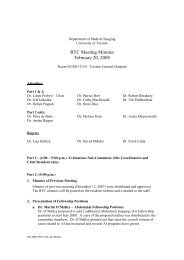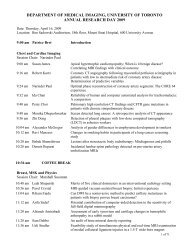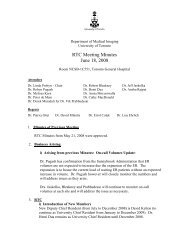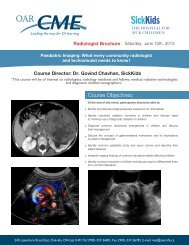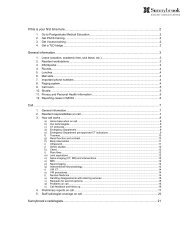Differentiation of Simple and Strangulated Small-Bowel Obstructions ...
Differentiation of Simple and Strangulated Small-Bowel Obstructions ...
Differentiation of Simple and Strangulated Small-Bowel Obstructions ...
You also want an ePaper? Increase the reach of your titles
YUMPU automatically turns print PDFs into web optimized ePapers that Google loves.
signs <strong>and</strong> symptoms <strong>of</strong> small-bowel strangulation<br />
or did not respond favorably to<br />
conservative treatment; they underwent<br />
simple adhesiotomy (n = 21) or segmental<br />
bowel resection (n = 34) to relieve the obstruction.<br />
Obstruction was confirmed during<br />
surgery in all 55 patients; 41 had strangulated<br />
obstructions <strong>and</strong> 14 had simple<br />
obstructions. <strong>Obstructions</strong> were caused by<br />
adhesions or b<strong>and</strong>s (n = 43), hernia (n =<br />
9), or volvulus (ri = 3). The time between<br />
surgery <strong>and</strong> CT ranged from a few hours<br />
to 13 days (mean, 2 days); for 31 patients,<br />
it was less than or equal to 1 day.<br />
In the other 29 patients, obstructions improved<br />
with fluid <strong>and</strong> electrolyte replacement<br />
<strong>and</strong>/or after the insertion <strong>of</strong> a nasogastric<br />
tube for 2-11 days (mean, 5 days)<br />
for decompression; in seven <strong>of</strong> these 29<br />
patients, long decompression tubes were<br />
used. Although not confirmed with surgeny,<br />
the obstructions <strong>of</strong> 14 <strong>of</strong> these 29 patients<br />
were diagnosed with small-bowel<br />
follow-through examinations: complete<br />
obstruction, two patients; high-grade partial<br />
obstruction, eight patients; <strong>and</strong> lowgrade<br />
partial obstruction, four patients.<br />
With use <strong>of</strong> CT criteria proposed by<br />
Fukuya et al (10) <strong>and</strong> Gazelle et al (11),<br />
findings consistent with small-bowel obstruction,<br />
<strong>and</strong> not paralytic ileus, were<br />
seen on the CT scans <strong>of</strong> 10 <strong>of</strong> the other 15<br />
patients. Diffuse small-bowel dilatation<br />
(luminal diameter, 3.5 cm) <strong>and</strong> collapsed<br />
distal small bowel, colon, on both were<br />
seen on the CT scans <strong>of</strong> these 10 patients.<br />
On the CT scans <strong>of</strong> the other five patients,<br />
small-bowel loops with luminal diameters<br />
less than 3.5 cm but greater than 3.0 cm<br />
were seen. The plain abdominal radiographs<br />
<strong>of</strong> these five patients, obtained<br />
within 1 week before CT, revealed findings<br />
typical <strong>of</strong> small-bowel obstruction (distended<br />
fluid-filled proximal loops, multiple<br />
step-ladder patterns <strong>of</strong> air-fluid 1evels,<br />
<strong>and</strong> collapsed distal small-bowel,<br />
colon, or both).<br />
We considered these 29 patients to have<br />
simple small-bowel obstruction. To support<br />
the belief that these patients did not<br />
have strangulated obstruction, the number<br />
<strong>of</strong> the following clinical features in these<br />
29 patients was compared with that in the<br />
41 patients with strangulated obstruction:<br />
abdominal tenderness, tachycardia (heart<br />
rate, > 100 beats per minute), fever (ternperature,<br />
>38.5#{176}C),<strong>and</strong> leukocytosis (white<br />
blood cell count, >10,000/mr& [10.0 X<br />
109/LJ). Of the 41 patients with strangulated<br />
obstruction, 12 patients had all four<br />
features, 10 had three, 16 had two, <strong>and</strong><br />
three had one. Of the 29 patients with<br />
simple obstruction, four patients had two<br />
<strong>of</strong> the features, 15 had one, <strong>and</strong> 10 had<br />
none.<br />
CT was performed with a GE 9800<br />
Quick System, a HiLight Advantage (GE<br />
Medical Systems, Milwaukee, Wis), or a<br />
Somatom Plus-S (Siemens, Erlangen, Germany)<br />
scanner. Sections <strong>of</strong> 8- or 10-mm<br />
thickness were imaged from the diaphragm<br />
to the pubis at intervals <strong>of</strong> 8 or 10 mm.<br />
Contrast material (500-800 mL; E-Z-CAT,<br />
2% iodinated, water soluble; E-Z-Em,<br />
Westbury, NY) was given orally 30 mm-<br />
Table 1<br />
Findings on CT Scans<strong>of</strong> 84 Patients with <strong>Strangulated</strong> or <strong>Simple</strong> Obstruction<br />
CT Findings<br />
<strong>Strangulated</strong><br />
(n = 41)<br />
<strong>Simple</strong><br />
(n = 43)<br />
<strong>Bowel</strong> wall changes<br />
Smootltserrated beak 5:13 26:0<br />
Target sign 12 3<br />
Wall thidmess (mean ± SD, mm) 5.1 ± 2.1 3.5 ± 1.0<br />




